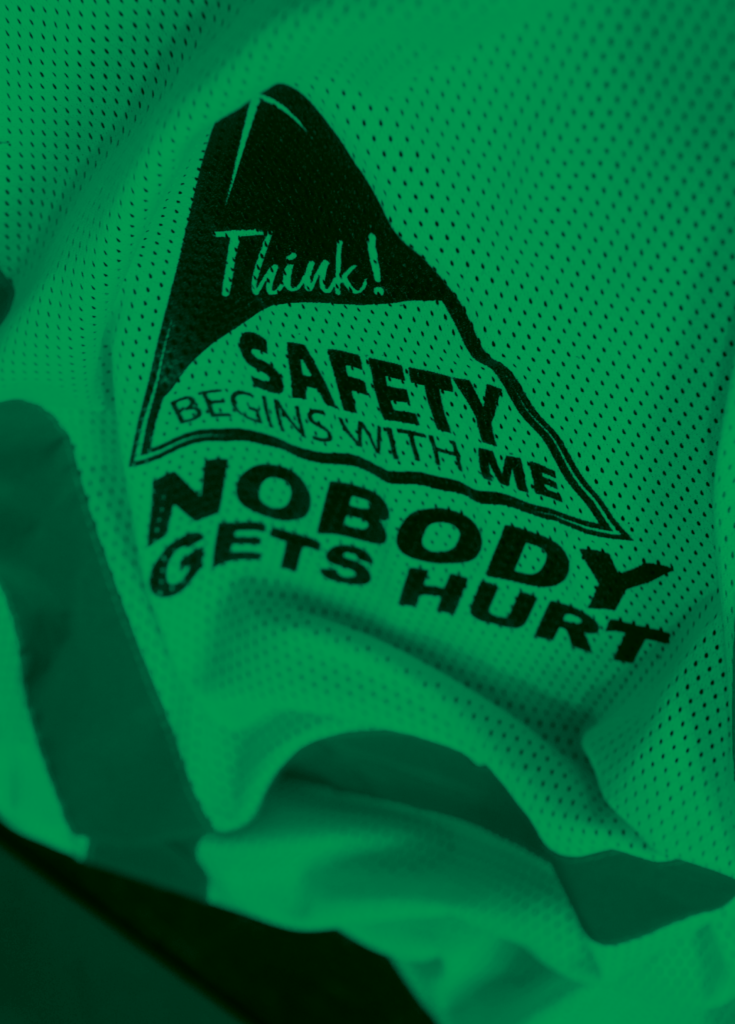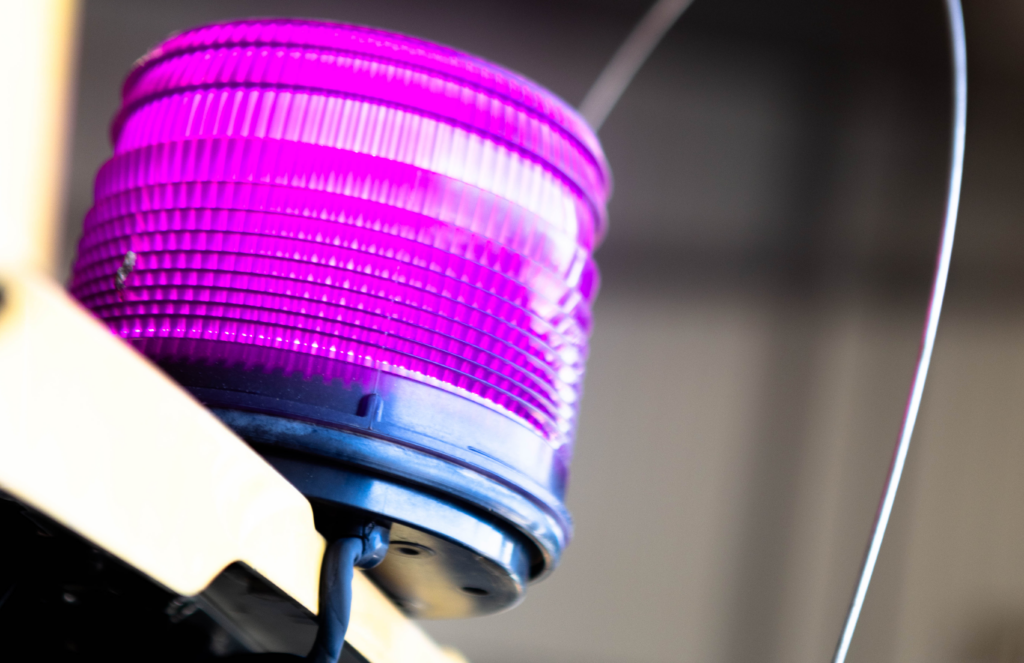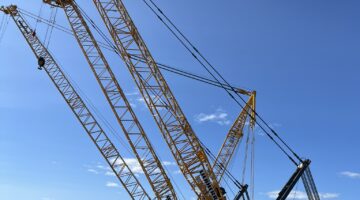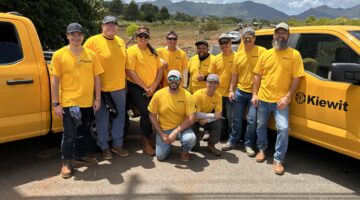New innovations are making equipment operation safer than ever, benefiting both operators and workers on the job.
Recent improvements in technology are taking equipment safety to a new level with seatbelt usage, personnel detection and collision mitigation systems.
Kiewit has been working with original equipment manufacturers (OEMs) for many years, partnering with them to help design and implement improved equipment safety features and tools, said Daenan Fairburn, equipment technology director.
“We’re at the point now where new technology outperforms similar legacy solutions, and at a much lower cost,” he said. “These tools provide immediate feedback and better data than we’ve ever had access to before. That gives projects the opportunity to identify and solve equipment safety challenges before an incident occurs.”
Steve Curry, vice president of Kiewit Equipment Services, emphasized the importance of these strong collaborative relationships with OEMs to make innovations happen.
“It’s our responsibility to push the OEMs that we do business with to innovate faster around equipment safety technology and make it available to us quicker,” he said. “We take this responsibility very seriously because equipment incidents are avoidable, and we owe it to our employees to put the safest equipment possible on our projects.”
The goal is to mitigate risks involved in operating and working around equipment, eliminating serious injuries and fatalities, said Curry, adding that some of these technologies are the last line of defense and save lives.
Buckle up for safety
Kiewit didn’t wait on manufacturers for a new seatbelt reminder system. The company has focused significant efforts retrofitting existing machines with features it believes will improve seatbelt usage and save lives. The system includes:
- A light and audible alarm inside the cab to remind the operator to buckle up
- Bright orange seatbelts that are clearly visible, making it easier for those on the ground to spot when a seatbelt isn’t being used
- A purple strobe light on top of each cab that alerts those on the ground when a seatbelt isn’t fastened
Senior Equipment Manager Jim Claypool said the company has also been working with OEMs to integrate seatbelt usage into telematics on the machines. Telematics can track if a machine is running without the seatbelt fastened. It can be set up with real-time notifications or presented in a report.
The system can send an alert (text or email) to a supervisor, notifying them that a machine is running without the seatbelt fastened. In the notification is a link that tells them which machine it is and where it is. Clicking on another link will provide GPS coordinates and directions on how to get there.
Why would Kiewit invest so much time and effort into the seatbelt system? Claypool said it’s because seatbelt usage has been proven to save lives. Too often in the construction industry, a worker is crushed by a machine after being thrown out or trying to jump out in a rollover situation.
“That’s about as serious as it gets when something like that happens,” said Claypool. “And so many serious injuries and deaths can be prevented by just using a seatbelt.”
Equipment operators need to understand that the rollover protection structure (ROPS) installed on most machines is there to protect them, but it can’t help if they’re not secured in the cab, he said.
Kiewit has focused the seatbelt initiative on machines that pose the greatest risk, including bulldozers, loaders, skid steers, motor graders, compactors and haul trucks.
At the end of 2024, the company has completed installation of the seatbelt reminder system on 1,860 machines identified for the upgrade.
Identifying people in the way
Another major equipment upgrade is the installation of personnel detection technology on telehandlers, compact track loaders, skid steer loaders and wheel loaders.

“The goal is to avoid incidents where we could potentially back over an employee with one of those four types of equipment,” said Curry.
The camera-based system will alert the operator that a person has entered a danger zone. The system sounds an audible alarm, and each cab is equipped with a monitor that shows where the individual is, left, right or behind the machine.
Inside the cab, the operator has a monitor that displays a rectangular box around a person detected in a danger zone. Marcus Bray, regional equipment manager, said the box is either green, yellow or red, depending on how close the person is. There is also an audible alarm — a beep when someone is in a yellow zone and a solid, louder alarm when someone is in a red zone.
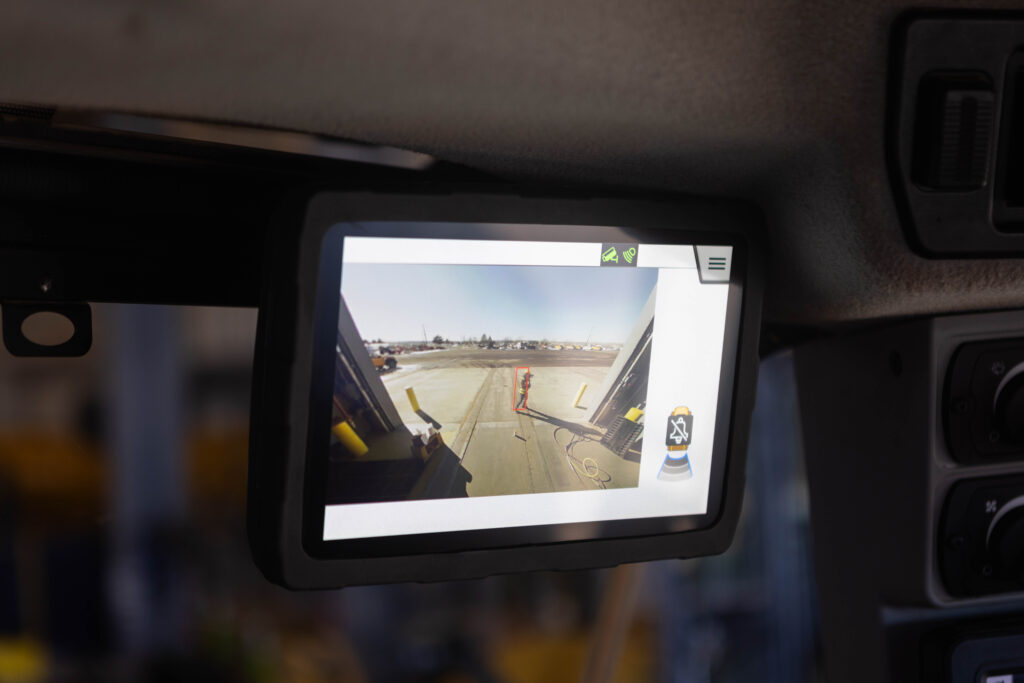
Bray said Kiewit tested multiple systems before selecting two versions: one for telehandlers and wheel loaders, and another for compact track loaders and skid steer loaders.
Kiewit began installing the technology late third quarter of 2024 in over 1,000 company-owned machines and plans to have the remaining features installed in early 2025. Kiewit collects data in real-time from each of the machines. This data will enable the projects to identify high-risk work areas and make changes in real time.
During testing, Bray said a telehandler equipped with the technology was detecting several hundred people throughout one shift. Within 30 minutes, the management team was able to identify the issue, reorganize the work area and reduce the detections to less than 10.
“It was easy to see that with just a little bit of data and a minimal amount of effort, we can become more effective in setting up our equipment operations and helping ensure that we reduce those risks,” Bray said.
Kiewit equipment will also be fitted with external alarms that alert an individual on the ground that they are too close to a machine. The goal of that feature is to change behaviors on the ground and take some of the burden off the operator, according to Bray.
“Operators who have tested or used the new technology love it,” Bray said. “It’s another level of protection to prevent them from hurting someone else, which is especially important with higher risk equipment like skid steers, telehandlers and loaders.”
Collision mitigation
Collision warning systems depend on the equipment operator or the person on the ground to act to prevent an injury. The operator must stop the machine or the person needs to get out of the way.
Two years from now, Kiewit will be able to purchase machines from its main construction equipment OEMs that have collision mitigation installed, said Curry. This new technology will be able to identify a person or object in the danger zone and automatically stop the machine without operator interaction.
“It won’t be a warning system. It will truly be a mitigation system,” Curry said. “So that’s our evolution. We’re starting with warning systems both in the cab and external, and moving toward mitigation over the next two years.”
Bray said the results of testing the collision mitigation technology on a front-end loader were impressive. With a full load in the bucket, the operator backed up as fast as he could go. When the system detected some trash cans in the way, it engaged the brakes and stopped the machine. In two hours of testing in a variety of configurations, the machine never knocked the trash cans over.
Because of the risk involved with incorporating the technology into a machine’s control system, Kiewit will wait on OEMs to deliver it in new equipment but continue to push them to do so as quickly as possible.
“I think it’s great that the company is willing to invest in this kind of technology,” said Project Safety Director John Cloutier. “The willingness to use what’s out there, provide feedback to manufacturers and grow with it as it gets better, says a lot about the company’s commitment to safety.”
